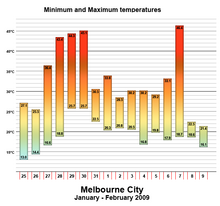
A heat wave, sometimes described as extreme heat, is a period of abnormally hot weather. High humidity often accompanies heat waves. This is especially the case in oceanic climate countries. Definitions vary but are similar. A heat wave is usually measured relative to the usual climate in the area and to normal temperatures for the season. Temperatures that humans from a hotter climate consider normal, can be regarded as a heat wave in a cooler area. This would be the case if the warm temperatures are outside the normal climate pattern for that area. Heat waves have become more frequent, and more intense over land, across almost every area on Earth since the 1950s. This is due to climate change.

The Black Friday bushfires of 13 January 1939, in Victoria, Australia, were part of the devastating 1938–1939 bushfire season in Australia, which saw bushfires burning for the whole summer, and ash falling as far away as New Zealand. It was calculated that three-quarters of the State of Victoria was directly or indirectly affected by the disaster, while other Australian states and the Australian Capital Territory were also badly hit by fires and extreme heat. This was the third-deadliest bushfire event in Australian history, only behind the 1983 Ash Wednesday bushfires and the 2009 Black Saturday bushfires.

Adelaide has a Mediterranean climate, with mild wet winters and hot dry summers.
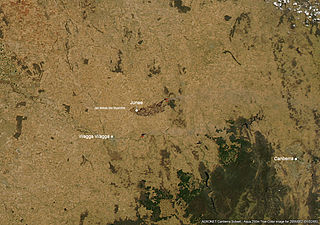
The 2006 Junee bushfire, officially referred to as the "Jail Break Inn fire", was a bushfire that burned from 1–6 January and primarily affected the Riverina region in the Australian state of New South Wales. At least 25,200 hectares of farmland and forest reserve in the municipality of Junee Shire were burned during the 6-day duration of the fire. Ten houses, four shearing sheds and numerous other vehicles and non-residential buildings were destroyed, and damage was also caused to the Junee Round House. Rural industry in the Junee area was also significantly affected by the fire; over 20,000 head of livestock perished or were put down due to fire related injuries, 20 hectares of unharvested crops were burned and 1,500 kilometres (930 mi) of fencing was damaged. The fire affected 200 properties in and around the communities of Bethungra, Eurongilly, Illabo, Junee and Old Junee.

The 2006 European heat wave was a period of exceptionally hot weather that arrived at the end of June 2006 in certain European countries. The United Kingdom, France, Belgium, the Netherlands, Luxembourg, Italy, Poland, the Czech Republic, Hungary, Germany and western parts of Russia were most affected.
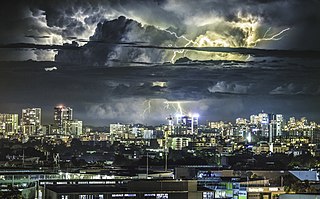
The climate of Sydney, Australia is humid subtropical, shifting from mild and cool in winter to warm and occasionally hot in the summer, with no extreme seasonal differences as the weather is moderated by proximity to the ocean, although more contrasting temperatures are recorded in the inland western suburbs. Despite the fact that there is no distinct dry or wet season, rainfall peaks during summer and autumn months, and is at its lowest just around the middle of the year, though precipitation can be erratic throughout the year. Precipitation varies across the region, with areas adjacent to the coast being the wettest. According to the Bureau of Meteorology, Sydney falls in the temperate climate zone which has warm to hot summers and no dry season. Sydney's plant hardiness zone ranges from zone 11a to 9b throughout the metropolitan area. Under the Holdridge Life Zones classification, eastern Sydney falls in the Subtropical Moist Forest zone and the western suburbs in the Subtropical Dry Forest zone.
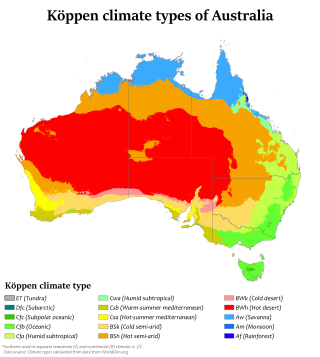
Australia's climate is governed mostly by its size and by the hot, sinking air of the subtropical high pressure belt. This moves north-west and north-east with the seasons. The climate is variable, with frequent droughts lasting several seasons, thought to be caused in part by the El Niño-Southern Oscillation. Australia has a wide variety of climates due to its large geographical size. The largest part of Australia is desert or semi-arid. Only the south-east and south-west corners have a temperate climate and moderately fertile soil. The northern part of the country has a tropical climate, varying between grasslands and desert. Australia holds many heat-related records: the continent has the hottest extended region year-round, the areas with the hottest summer climate, and the highest sunshine duration.
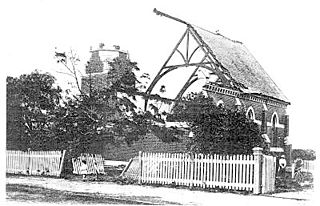
Extreme weather events in Melbourne, Australia have occurred on multiple occasions. The city has experienced a number of highly unusual weather events and extremes of weather. An increase in heat waves and record breaking temperatures in the 21st century has led to much discussion over the effects of climate change in the country.

Launceston, Tasmania has a cool, temperate climate, with four distinct seasons. The city is located in the Tamar Valley in Northern Tasmania and is surrounded by many large hills and mountains. With this type of topography, Launceston's weather patterns can change considerably in a short period.

A bushfire season occurred predominantly from June 2009 to May 2010. Increased attention has been given to this season as authorities and government attempt to preempt any future loss of life after the Black Saturday bushfires during the previous season, 2008–09. Long range weather observations predict very hot, dry and windy weather conditions during the summer months, leading to a high risk of bushfire occurrence.
The 1906 British Isles heatwave occurred across the British Isles in August and September 1906. The heat wave had a comparable intensity to the 1990 heat wave. From 31 August to 3 September, the temperature in the UK exceeded 32 °C (90 °F) consecutively over much of the UK. In September, Central England and Birmingham recorded a maximum temperature of 31.5 °C (88.7 °F), while Oxford recorded a maximum temperature of 33.1 °C (91.6 °F).

The 2010 Northern Hemisphere summer heat waves included severe heat waves that impacted most of the United States, Kazakhstan, Mongolia, China, Hong Kong, North Africa and the European continent as a whole, along with parts of Canada, Russia, Indochina, South Korea and Japan during July 29 2010. The first phase of the global heatwaves was caused by a moderate El Niño event, which lasted from June 2009 to May 2010. The first phase lasted only from April 2010 to June 2010, and caused only moderate above average temperatures in the areas affected. But it also set new record high temperatures for most of the area affected, in the Northern Hemisphere. The second phase was caused by a very strong La Niña event, which lasted from June 2010 to June 2011. According to meteorologists, the 2010–11 La Niña event was one of the strongest La Niña events ever observed. That same La Niña event also had devastating effects in the Eastern states of Australia. The second phase lasted from June 2010 to October 2010, caused severe heat waves, and multiple record-breaking temperatures. The heatwaves began in April 2010, when strong anticyclones began to develop, over most of the affected regions, in the Northern Hemisphere. The heatwaves ended in October 2010, when the powerful anticyclones over most of the affected areas dissipated.
The Australian summer of 2012–2013, known as the Angry Summer or Extreme Summer, resulted in 123 weather records being broken over a 90-day period, including the hottest day ever recorded for January on record, the hottest summer average on record, and a record seven days in a row when the whole country averaged above 39 °C (102 °F). Single-day temperature records were broken in dozens of towns and cities, as well as single-day rainfall records, and several rivers flooded to new record highs.
In May 2015, India was struck by a severe heat wave. As of 3 June 2015, it caused the deaths of at least 2,500 people in multiple regions. The heat wave occurred during the Indian dry season, which typically lasts from March to July with peak temperatures in April and May. Although it typically remains hot until late October, Indian monsoons often provide some respite from the heat.
Perth, the capital city of the state of Western Australia, has a Mediterranean climate, with hot, dry summers and mild, wet winters. February is the hottest month of the year, with an average high of 31.6 °C (88.9 °F), and July is the coldest month of the year, with an average low of 7.9 °C (46.2 °F). 77% of rain in Perth falls between May and September. Perth has an average of 8.8 hours of sunshine per day, which equates to around 3,200 hours of annual sunshine, and 138.7 clear days annually, making it the sunniest capital city in Australia.
The 2014 Adelaide heatwave was a heat wave that occurred in Adelaide, South Australia in both January and February 2014. The heatwaves were so strong that it broke records, becoming the hottest summer ever recorded in Adelaide. Although there were no deaths directly linked to the heatwave as of 2015, there were at least 136 heat-related hospital admissions recorded.

The 2018 European drought and heat wave was a period of unusually hot weather that led to record-breaking temperatures and wildfires in many parts of Europe during the spring and summer of 2018. It is part of a larger heat wave affecting the northern hemisphere, caused in part by the jet stream being weaker than usual, allowing hot high-pressure air to linger in the same place. According to the European Drought Observatory, most of the areas affected by drought are across northern and central Europe. According to the World Meteorological Organization, the severe heat waves across the northern hemisphere in the summer of 2018, are linked to climate change in Europe, as well as events of extreme precipitation.

In 2022, several areas of the world experienced heat waves. Heat waves were especially notable in East Asia, the Indian subcontinent, Australia, western Europe, the United States, and southern South America. 2022 heat waves accounted for record-breaking temperatures and, in some regions, heat-related deaths. Heat waves were worsened by the effects of climate change, and they exacerbated droughts and wildfires.
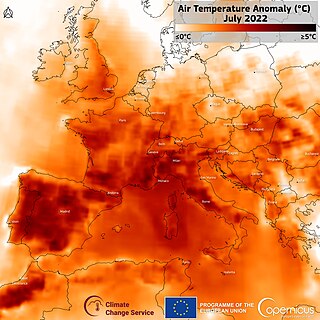
From June to August 2022, persistent heatwaves affected parts of Europe, causing evacuations and a confirmed death toll of 24,501. However, upper estimates suggested more than 61,000 heat-related deaths between 30 May and 4 September. These heat waves were the deadliest meteorological events in 2022. The highest temperature recorded was 47.0 °C (116.6 °F) in Pinhão, Portugal, on 14 July.


